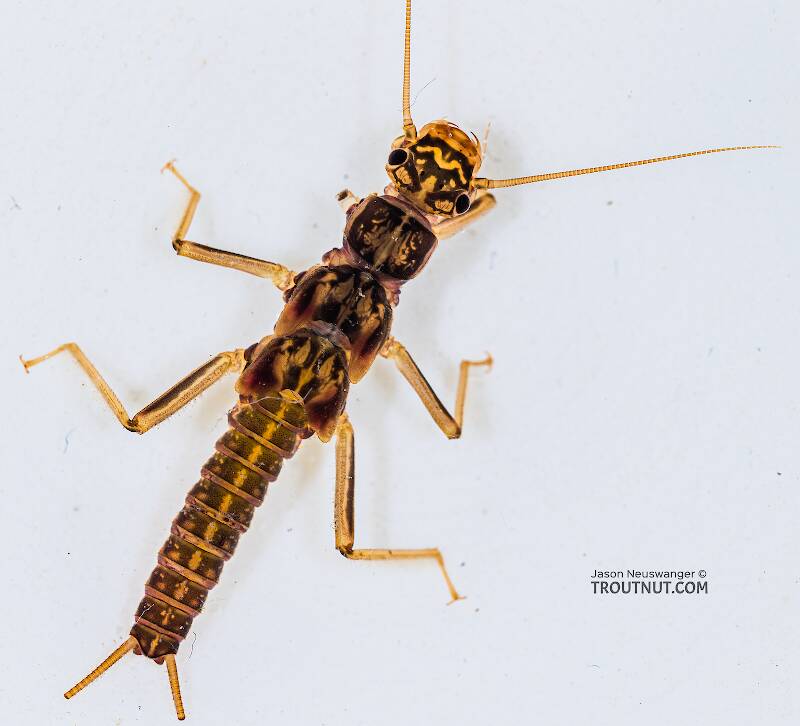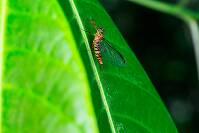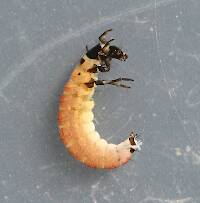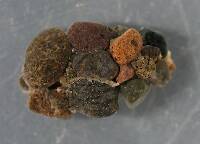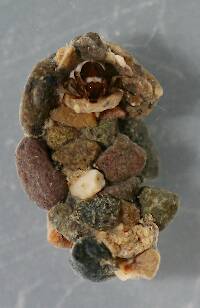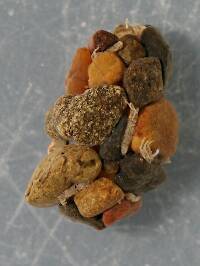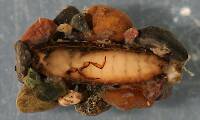
Blue-winged Olives
Baetis
Tiny Baetis mayflies are perhaps the most commonly encountered and imitated by anglers on all American trout streams due to their great abundance, widespread distribution, and trout-friendly emergence habits.
Featured on the forum

This wild-looking little thing completely puzzled me. At first I was thinking beetle or month larva, until I got a look at the pictures on the computer screen. I made a couple of incorrect guesses before entomologist Greg Courtney pointed me in the right direction with Psychodidae. He suggested a possible genus of Thornburghiella, but could not rule out some other members of the tribe Pericomini.

Troutnut is a project started in 2003 by salmonid ecologist Jason "Troutnut" Neuswanger to help anglers and
fly tyers unabashedly embrace the entomological side of the sport. Learn more about Troutnut or
support the project for an enhanced experience here.
This topic is about the Stonefly Genus Skwala
The genus Skwala (Short-winged Springflies) of the Perlodidae family is represented by three species in North America, Skwala americana, the identical-looking Skwala curvata, and Skwala compacta. Skwala should be included in any comprehensive list of important stoneflies for the western flyfisher. Though often mistakenly thought of as members of the Perlidae (Golden Stones) that happen to hatch early, they are actually quite different and often far more important on many western rivers than their more publicized cousins. Perhaps the most significant factors regarding this growing recognition are their inhabiting tailwaters previously too warm for trout and the lengthening of trout seasons, both relatively recent phenomena. This explains the scant mention they have received (if any) in older angling literature.Excepting the lake dwelling compacta, they are lovers of cobble bottomed riffles and runs of larger mid to low elevation rivers. Their behavior is consistent with other large stoneflies except that they are more prone to floating long distances as they placidly oviposit, and with the exception of Pteronarcys californica (Salmon Flies) in some locations, they do it in larger numbers. There is usually no challenge to them for the fish's attention until Rhithrogena morrisoni (March Brown) mayflies begin to appear a few weeks later. Their flights occur during the warmest part of the day which usually means in the afternoon, though impressive flights have been observed around the lunch hour. Regardless, they finish well before dark.
The river-dwelling adults have smoky brown to brown wings, brown legs, and either primrose (often tinged w/ olive) abdomens ribbed with brown or the reverse in darker strains. The males are brachypterous, smaller and usually darker. Both sexes thoracic ventrals are a curiously marked yellow/dark brown variegated pattern. Gravid females carry blackish pea shaped egg clusters off the tips of their abdomens that are much larger in diameter.
Example specimens
Bnewell on Jul 26, 2012July 26th, 2012, 6:56 pm EDT
In a recent publication the name of this species was changed to Skwala compacta.
PaulRoberts on Jul 27, 2012July 27th, 2012, 8:12 am EDT
Thanks for the update.
Entoman on Jul 27, 2012July 27th, 2012, 9:41 am EDT
Hi Bob,
Thanks for the heads-up. I pasted your comment on the species page from your previous blog on this topic. Do you have the name of the paper and any photos you could share?
BTW - In a recent post that fell off the board before you probably saw it, Taxon asked if you were aware of any reason why the Plecoptera Society's list hasn't been updated since '09? The change you mention hasn't shown up there yet, which means there may be others? The hatch pages depend on this site for stoneflies as they do Clemson's list for caddis and Purdue's for mayflies. These have been the guidelines used for the taxonomic listings here as it is the understanding (hope) they represent the general consensus and are updated on a regular basis.
Thanks for the heads-up. I pasted your comment on the species page from your previous blog on this topic. Do you have the name of the paper and any photos you could share?
BTW - In a recent post that fell off the board before you probably saw it, Taxon asked if you were aware of any reason why the Plecoptera Society's list hasn't been updated since '09? The change you mention hasn't shown up there yet, which means there may be others? The hatch pages depend on this site for stoneflies as they do Clemson's list for caddis and Purdue's for mayflies. These have been the guidelines used for the taxonomic listings here as it is the understanding (hope) they represent the general consensus and are updated on a regular basis.
"It's not that I find fishing so important, it's just that I find all other endeavors of Man equally unimportant... And not nearly as much fun!" Robert Traver, Anatomy of a Fisherman
GONZO on Jul 27, 2012July 27th, 2012, 4:55 pm EDT
Do you have the name of the paper...?
"A Taxonomic Revision of the Genus Arcynopteryx Klapalek, 1904 (Plecoptera, Perlodidae)" Teslenko, 2012. The abstract is available here: http://www.mapress.com/zootaxa/2012/f/z03329p018f.pdf
Entoman on Jul 27, 2012July 27th, 2012, 7:18 pm EDT
Thanks, Gonzo. By chance, have you heard anything regarding Taxon's question?
"It's not that I find fishing so important, it's just that I find all other endeavors of Man equally unimportant... And not nearly as much fun!" Robert Traver, Anatomy of a Fisherman
GONZO on Jul 28, 2012July 28th, 2012, 5:14 am EDT
I don't know what (if anything) determines the frequency of updates, Kurt, but that list has the additional drawback of of not listing the date with the nominating author and does not include synonyms. Personally, I find this site much more useful: http://plecoptera.speciesfile.org/HomePage.aspx
Although the recent change in the status of Arcynopterx/Skwala compacta is not (yet?) reflected on the species page, the paper that proposes the change is included in the reference list on the Arcynopteryx genus page.
Although the recent change in the status of Arcynopterx/Skwala compacta is not (yet?) reflected on the species page, the paper that proposes the change is included in the reference list on the Arcynopteryx genus page.
Entoman on Jul 28, 2012July 28th, 2012, 2:01 pm EDT
Thanks, Gonzo. And thanks for mentioning the link!
"It's not that I find fishing so important, it's just that I find all other endeavors of Man equally unimportant... And not nearly as much fun!" Robert Traver, Anatomy of a Fisherman
Quick Reply
Related Discussions
Topic
Replies
Last Reply
3
Feb 12, 2009
by Creno
by Creno
2
Jul 3, 2013
by Feathers5
by Feathers5



